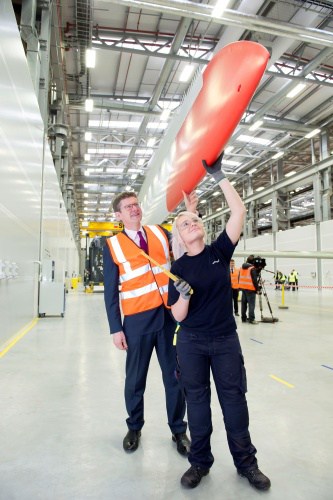
The £310m redevelopment of Alexandra Dock by Siemens and Associated British Ports will create 1,000 jobs, 700 of which have already been filled by local people.
The site - which represents Hull’s largest-ever inward investment and is one of Siemens’ largest-ever investments worldwide in manufacturing facilities - includes a factory which will manufacture blades 75m long, and a dockside plant assembling turbine towers 82m tall.
Hugh McNeal, chief executive of industry trade body RenewableUK,hailed the opening as a major step forward for the UK sector. “Innovative, large-scale manufacturing for Britain’s offshore wind industry, as Siemens are doing here in Hull, is a key part of our nation’s modern industrial strategy. It’s great to see a major international company building on Yorkshire’s proud manufacturing history.”
Visiting the new facility as the first 75m blade rolled off the production line business secretary Greg Clark MP said: “Hull has established itself as an important manufacturing and engineering centre for this innovative and exciting new industry. In the coming years the new offshore wind projects that this factory will supply could generate enough clean electricity to power over three million homes and businesses – all with wind turbine blades produced by the dedicated and highly skilled Siemens workforce right here in Hull.
Predicting the facility will have a major economic impact on the UK Siemens UK chief executive Juergen Maier said: “This new factory signals a positive future for manufacturing in this country. This is a world-class facility – innovative, productive and competitive – that generates real value for the local community and the UK economy.”
The first wind farm that will benefit from Hull is Dudgeon, off the Norfolk coast, which will be able to use the facility and quayside for part of its installation of Siemens offshore wind turbines.
The Dudgeon wind farm will comprise 67 of Siemens’ 6 MW offshore wind turbines, which have the world’s longest blade in commercial operation at 75m in length. With an overall capacity of 402MW Dudgeon will provide clean power to over 410,000 UK households.





Project to investigate hybrid approach to titanium manufacturing
What is this a hybrid of? Superplastic forming tends to be performed slowly as otherwise the behaviour is the hot creep that typifies hot...